Spatio-Temporal Paths and Influencing Factors of Residential Mobility in Guangzhou: A Micro-Level Perspective of Newly Employed College Graduates
Abstract
1. Introduction
2. Literature Review
2.1. Research Perspectives on Residential Mobility
2.2. Spatio-Temporal Characteristics of Residential Mobility
2.3. Factors Influencing Residential Mobility
2.4. Research Data and Methods on Residential Mobility
3. Materials and Methods
3.1. Study Area
3.2. Study Data
3.3. Study Method
3.3.1. Spatio-Temporal Path Visualization
- Establishing the spatio-temporal database: In time geography, all human activities are considered behaviors that occur within specific spatial and temporal ranges. As such, the spatio-temporal database for residential mobility must include both the basic attributes of individuals and the spatial coordinates associated with their migration process. To represent these processes effectively, specific migration paths are depicted using straight-line distances.
- Generating and analyzing spatio-temporal paths: In this stage, three-dimensional GIS analysis tools are combined with the Space Time Path analysis plugin to generate spatio-temporal path curves for residential mobility. Subsequently, attribute calculation tools are used to measure the length of migration paths and calculate the central coordinates of migration locations for each time group. This enables a detailed analysis of migration trends across different life stages.
- Three-dimensional visualization: Using the ArcScene module in GIS, the study visualizes spatio-temporal path curves, with time serving as the time coordinate. This step facilitates the analysis of residential mobility path characteristics across different time stages, providing an intuitive understanding of the data.
3.3.2. Variable Selection and Model Construction for Residential Mobility
4. Results
4.1. Spatio-Temporal Paths of Residential Mobility Among NECGs in Guangzhou
4.2. Influencing Factors on Residential Mobility of NECGs in Guangzhou
5. Discussion
6. Conclusions
- Recommendations for the Housing Demand Side:
- 2.
- Recommendations for the Housing Supply Side:
- 3.
- Recommendations for the Housing Regulation Side:
Author Contributions
Funding
Data Availability Statement
Acknowledgments
Conflicts of Interest
References
- Lantz, H.R.; Rossi, P.H. Why Families Move: A Study in the Social Psychology of Urban Residential Mobility. Marriage Fam. Living 1957, 19, 303–304. [Google Scholar] [CrossRef]
- Clark, W.; Burt, J. The impact of workplace on residential relocation. Ann. Assoc. Am. Geogr. 1980, 70, 59–66. [Google Scholar] [CrossRef]
- Clark, W.; Duque-Calvache, R.; Palomares-Linares, I. Place attachment and the decision to stay in the neighbourhood: Place attachment and staying in the neighbourhood. Popul. Space Place 2017, 23, e2001. [Google Scholar] [CrossRef]
- Kendig, H.L. Housing Careers, Life Cycle and Residential Mobility: Implications for the Housing Market. Urban Stud. 2016, 21, 271–283. [Google Scholar] [CrossRef]
- Spring, A. Influence of proximity to kin on residential mobility and destination choice: Examining local movers in metropolitan areas. Demography 2017, 54, 1277–1304. [Google Scholar] [CrossRef]
- Li, S.; Mao, S. The spatial pattern of residential mobility in Guangzhou, China. Int. J. Urban Reg. Res. 2019, 43, 963–982. [Google Scholar] [CrossRef]
- Li, B.; Cao, Q.; Muhammad, M. Factors influencing the settlement intentions of Chinese migrants in cities: An analysis of air quality and higher income opportunity as predictors. Int. J. Environ. Res. Public Health 2020, 17, 7432. [Google Scholar] [CrossRef]
- Chen, L.; Xi, M.; Jin, W.; Hu, Y. Spatial pattern of long-term residence in the urban floating population of China and its influencing factors. China Geogr. Sci. 2021, 31, 342–358. [Google Scholar] [CrossRef]
- Schouten, A. Residential mobility and the geography of low-income households. Urban Stud. 2021, 58, 1846–1865. [Google Scholar] [CrossRef]
- Yi, C.; Huang, Y. Housing Consumption and Housing Inequality in Chinese Cities during the First Decade of the Twenty-First Century. Hous. Stud. 2014, 29, 291–311. [Google Scholar] [CrossRef]
- Huang, X.; Van, W.; Tang, S. To move or not to move? Residential mobility of rural migrants in a medium-sized Chinese city: The case of Yangzhou. Hous. Stud. 2021, 36, 278–301. [Google Scholar] [CrossRef]
- Iglesias, P.R. Social discourse, housing search and residential segregation: The social determinants of recent economic migrants’ residential mobility in Seville. Hous. Stud. 2019, 34, 1163–1188. [Google Scholar] [CrossRef]
- Gu, H.; Liu, Z.; Shen, T. Spatial pattern and determinants of migrant workers’ interprovincial hukou transfer intention in China: Evidence from a National Migrant Population Dynamic Monitoring Survey in 2016. Popul. Space Place 2020, 26, e2250. [Google Scholar] [CrossRef]
- Huang, Q.; Zhou, Q.; Song, W. Multidimensional turn and scale response in the study of urban residential differentiation in the new era. Prog. Geogr. 2023, 42, 573–586. [Google Scholar] [CrossRef]
- Coulter, R.; Maarten, V.; Findlay, A.M. Re-thinking residential mobility: Linking lives through time and space. Prog. Hum. Geogr. 2016, 40, 352–374. [Google Scholar] [CrossRef]
- Li, S.; Siu, Y. Residential Mobility and Urban Restructuring under Market Transition: A Study of Guangzhou, China. Prof. Geogr. 2010, 53, 219–229. [Google Scholar] [CrossRef]
- Wilson, A.G. A statistical theory of spatial distribution models. Transp. Res. 1967, 1, 253–269. [Google Scholar] [CrossRef]
- Yuan, M. Wildfire conceptual modelling for building GIS space-time model. In Temporal Data in Geographic Information Systems; Frank, A.U., Kuhn, W., Haunold, P., Eds.; Springer: Berlin/Heidelberg, Germany, 1995; pp. 47–56. [Google Scholar]
- Friedsam, H.J. Inter-Regional Migration of the Aged in the United States. J. Gerontol. 1951, 6, 237–242. [Google Scholar] [CrossRef]
- Matherly, W.J.; Hoyt, H. The Structure and Growth of Residential Neighborhoods in American Cities. South. Econ. J. 1940, 7, 268–269. [Google Scholar] [CrossRef]
- Wolpert, J. Behavioral Aspects of the Decision to Migrate. Pap. Reg. Sci. 1965, 15, 159–169. [Google Scholar] [CrossRef]
- Wolpert, J. Migration as an Adjustment to Environmental Stress. J. Soc. Issues 1966, 22, 92–102. [Google Scholar] [CrossRef]
- Spearea, J. Residential satisfactionasan intervening variable in residential mobility. Demography 1974, 11, 173–188. [Google Scholar] [CrossRef] [PubMed]
- Alonso, W. Location and Land Use: Toward a General Theory of Land Rent; Oxford University Press: London, UK, 1964. [Google Scholar]
- Quigley, J.M.; Weinberg, D.H. Intra-urban residential mobility: A review and synthesis. Int. Reg. Sci. Rev. 1977, 2, 41–66. [Google Scholar] [CrossRef]
- Crowley, S. The affordable housing crisis: Residential mobility of poor families and school mobility of poor children. J. Negro Educ. 2003, 72, 22–38. [Google Scholar] [CrossRef]
- Scanlon, E.; Devine, K. Residential mobility and youth well-being: Research, policy, and practice issues. J. Sociol. Soc. Welf. 2001, 28, 119. [Google Scholar] [CrossRef]
- Coulter, R.; van Ham, M. Following People Through Time: An Analysis of Individual Residential Mobility Biographies. Hous. Stud. 2013, 28, 1037–1055. [Google Scholar] [CrossRef]
- Xie, Y.; Jin, Y. Household Wealth in China. Chin. Sociol. Rev. 2015, 47, 203–229. [Google Scholar] [CrossRef]
- Kemper, F.J. Residential mobility in East and West Germany: Mobility rates, mobility reasons, reurbanization. Z. Bevölkerungswiss. 2008, 33, 293–314. [Google Scholar] [CrossRef]
- Lin, S.; Wu, F.; Wang, Y.; Li, Z. Migrants’ perceived social integration in different housing tenures in urban China. Geoforum 2023, 139, 103693. [Google Scholar] [CrossRef]
- Lu, M. Analyzing migration decisionmaking: Relationships between residential satisfaction, mobility intentions, and moving behavior. Environ. Plan. A 1998, 30, 1473–1495. [Google Scholar] [CrossRef]
- Clark, W.; Deurloo, M.; Dieleman, F. Residential Mobility and Neighbourhood Outcomes. Hous. Stud. 2006, 21, 323–342. [Google Scholar] [CrossRef]
- Smith, B.; Olaru, D. Lifecycle stages and residential location choice in the presence of latent preference heterogeneity. Environ. Plan. A Econ. Space 2013, 45, 2495–2514. [Google Scholar] [CrossRef]
- Lee, B.; Waddell, P. Residential mobility and location choice: A nested logit model with sampling of alternatives. Transportation 2010, 37, 587–601. [Google Scholar] [CrossRef]
- Harold, E.; Leonard, Z. Tenure choice, housing demand and residential location. J. Real Estate Res. 1991, 6, 341–356. [Google Scholar]
- Źróbek, S.; Trojanek, M.; Źróbek-Sokolnik, A.; Trojanek, R. The influence of environmental factors on property buyers’ choice of residential location in Poland. J. Int. Stud. 2015, 8, 164–174. [Google Scholar]
- Kim, J.H.; Pagliara, F.; Preston, J. The intention to move and residential location choice behaviour. Urban Stud. 2005, 42, 1621–1636. [Google Scholar] [CrossRef]
- Hou, Z.; Li, X.; Li, X. Determinants of Intra-City Residential Migration Patterns of Older Adults: A GIS and Decision Tree Analysis of Yancheng City, China. ISPRS Int. J. Geo-Inf. 2024, 13, 324. [Google Scholar] [CrossRef]
- Chen, J.; Chen, C.; Timmermans, H. Accessibility tradeoffs in household residential location decisions. Transp. Res. Rec. J. Transp. Res. Board 2008, 2077, 71–79. [Google Scholar] [CrossRef]
- Dorigo, G.; Tobler, W. Push-Pull Migration Laws. Ann. Assoc. Am. Geogr. 2010, 73, 1–17. [Google Scholar] [CrossRef]
- Zhang, Z.F.; Pan, J.; Pan, Y.P.; Li, M. Biogeography, Assembly Patterns, Driving Factors, and Interactions of Archaeal Community in Mangrove Sediments. mSystems 2021, 6, 10–1128. [Google Scholar] [CrossRef]
- Jia, X.; Lei, J. Residential Mobility of Locals and Migrants in Northwest Urban China. Sustainability 2019, 11, 3507. [Google Scholar] [CrossRef]
- Cui, C. Housing career disparities in urban China: A comparison between skilled migrants and locals in Nanjing. Urban Stud. 2018, 57, 546–562. [Google Scholar] [CrossRef]
- Bailey, A.J. Population geography: Lifecourse matters. Prog. Hum. Geogr. 2008, 33, 407–418. [Google Scholar] [CrossRef]
- Findlay, A.; McCollum, D.; Coulter, R.; Gayle, V. New mobilities across the life course: A framework for analysing demographically linked drivers of migration. Popul. Space Place 2015, 21, 390–402. [Google Scholar] [CrossRef]
- Ye, L.; Song, W.; He, M.; Liu, C. The Patterns and Mechanisms of Residential Mobility in Nanjing, China: Insights from the Mantel Test. ISPRS Int. J. Geo-Inf. 2024, 13, 17. [Google Scholar] [CrossRef]
- Hägerstrand, T. What about people in regional science? Pap. Reg. Sci. Assoc. 1970, 24, 7–21. [Google Scholar] [CrossRef]
- Chen, J.; Wang, B. “Unattended” Retirement: Lifestyle Migration and Precarity of the Houniao. Popul. Space Place 2020, 26, e2369. [Google Scholar] [CrossRef]
- Shaw, S.; Yu, H. A GIS-based time-geographic approach of studying individual activities and interactions in a hybrid physical-virtual space. J. Transp. Geogr. 2009, 17, 141–149. [Google Scholar] [CrossRef]
- Yu, H.; Shaw, S. Exploring potential human activities in physical and virtual spaces: A spatio-temporal GIS approach. Int. J. Geogr. Inf. Sci. 2008, 22, 409–430. [Google Scholar] [CrossRef]
- Hariharan, R.; Toyama, K. Project Lachesis: Parsing and modeling location histories. Geogr. Inf. Sci. 2004, 3234, 106–124. [Google Scholar]
- Peuquet, D.J.; Duna, N. An event-based spatio-temporal data model (ESTDM) for temporal analysis of geographical data. Int. J. Geogr. Inf. Syst. 1995, 9, 7–24. [Google Scholar] [CrossRef]
- Petzold, K. Mobility experience and mobility decision-making: An experiment on permanent migration and residential multilocality. Popul. Space Place 2017, 23, e2065. [Google Scholar] [CrossRef]
- Li, S.; Mao, S.; Du, H. Residential mobility and neighbourhood attachment in Guangzhou, China. Environ. Plan. A Econ. Space 2018, 51, 761–780. [Google Scholar] [CrossRef]
- Baláž, V.; Williams, A.M.; Fifekova, E. Migration decision making as complex choice: Eliciting decision weights under conditions of imperfect and complex information through experimental methods. Popul. Space Place 2016, 22, 36–53. [Google Scholar] [CrossRef]
- Sermons, M.W.; Koppelman, F.S. Representing the differences between female and male commute behavior in residential location choice models. J. Transp. Geogr. 2001, 9, 101–110. [Google Scholar] [CrossRef]
- Huang, C.; Liu, Y.; Pan, Z.; Wu, R. Modelling Locational Choices of Older Adults in China, 2010–2015. Appl. Geogr. 2023, 155, 102954. [Google Scholar] [CrossRef]
- Li, T.W.; Shen, H.F.; Zeng, C.; Yuan, Q.Q.; Zhang, L.P. Point-surface fusion of station measurements and satellite observations for mapping PM 2.5 distribution in China: Methods and assessment. Atmos. Environ. 2017, 152, 477–489. [Google Scholar] [CrossRef]
- Huang, Y.; Yi, D.; Clark, W. Multiple home ownership in Chinese cities: An institutional and cultural perspective. Cities 2020, 97, 102518. [Google Scholar] [CrossRef]
- Liu, Y.; Huang, C.; Wu, R.; Pan, Z.; Gu, H. The Spatial Patterns and Determinants of Internal Migration of Older Adults in China from 1995 to 2015. J. Geogr. Sci. 2022, 32, 2541–2559. [Google Scholar] [CrossRef]
- Tan, R.H.; Wang, T. Stay, Relocation or Wait: Community differentiation and governance of migrants in urbanization. Beijing Norm. Univ. Soc. Sci. 2019, 56, 130–140. (In Chinese) [Google Scholar]
- Wang, Y.P.; Murie, A. The New Affordable and Social Housing Provision System in China: Implications for Comparative Housing Studies. Int. J. Hous. Policy 2011, 11, 237–254. [Google Scholar] [CrossRef]
- Ma, Z.Y. The difference of urban residents’ emigration intention caused by haze and its influencing factors—A case study of Baoding City. Saf. Environ. Eng. 2019, 26, 37–43. (In Chinese) [Google Scholar]
- Liang, D.; Wang, Y.; Wang, Y.; Ma, C. National air pollution distribution in China and related geographic, gaseous pollutant, and socio-economic factors. Environ. Pollut. 2019, 250, 998–1009. [Google Scholar] [CrossRef] [PubMed]
- Cui, C.; Geertman, S.; Hooimeijer, P. Access to homeownership in urban China: A comparison between skilled migrants and skilled locals in Nanjing. Cities 2016, 50, 188–196. [Google Scholar] [CrossRef]
- Li, S.; Li, L. Life Course and Housing Tenure Change in Urban China: A Study of Guangzhou. Housing Stud. 2006, 21, 653–670. [Google Scholar] [CrossRef]
- Liu, Y.; Yu, S.; Sun, T. Heterogeneous Housing Choice and Residential Mobility Under Housing Reform in China: Evidence From Tianjin. Appl. Geogr. 2021, 129, 11–19. [Google Scholar] [CrossRef]
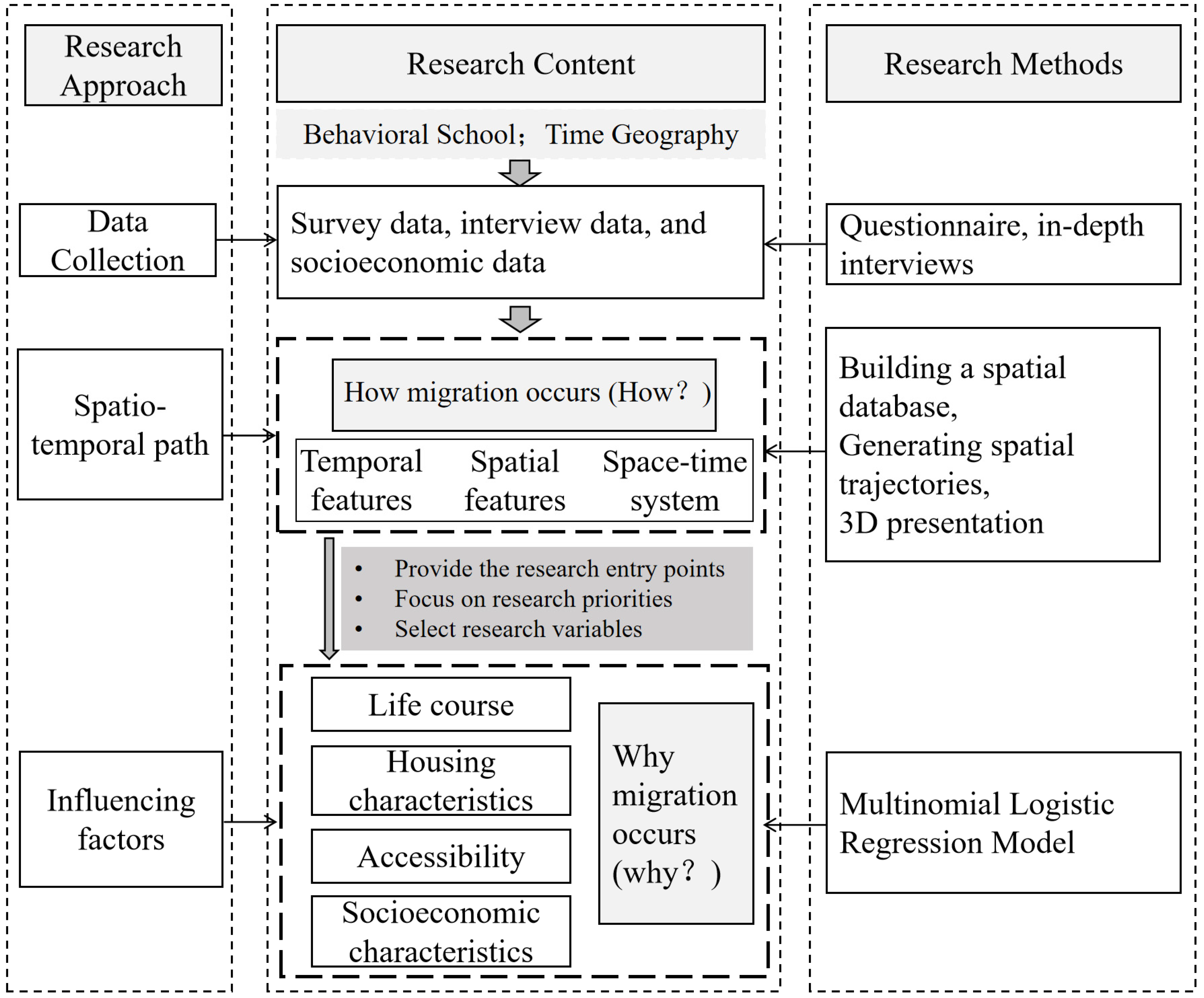
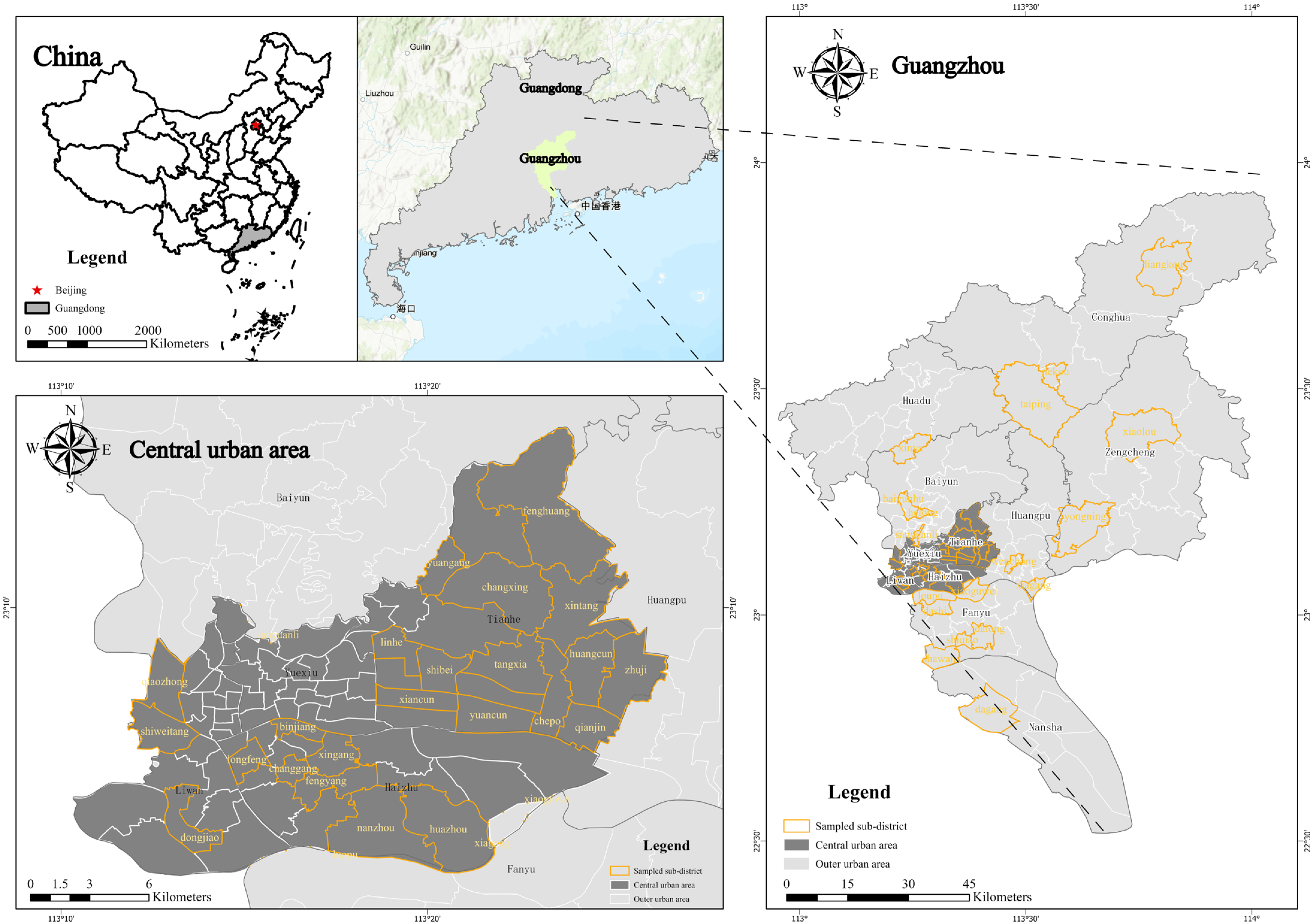
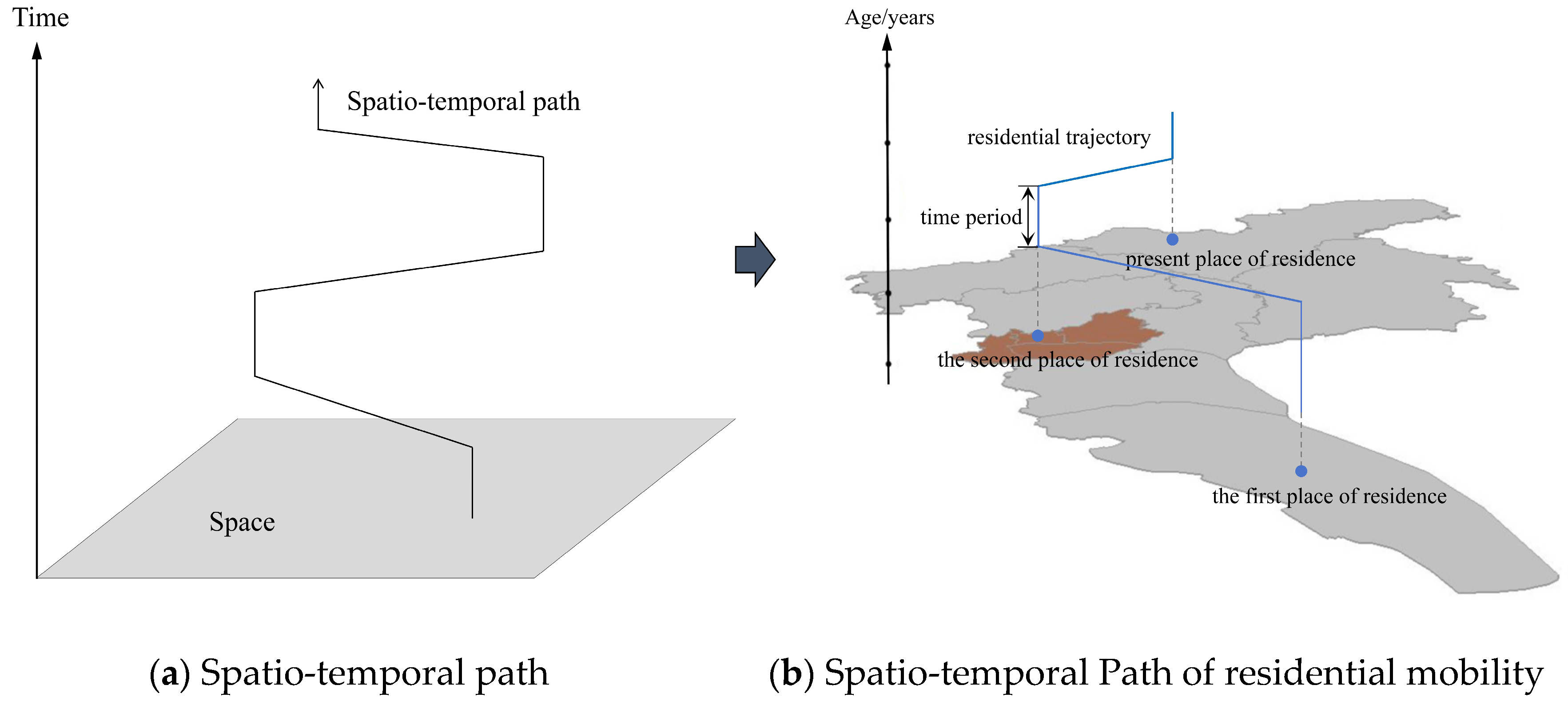
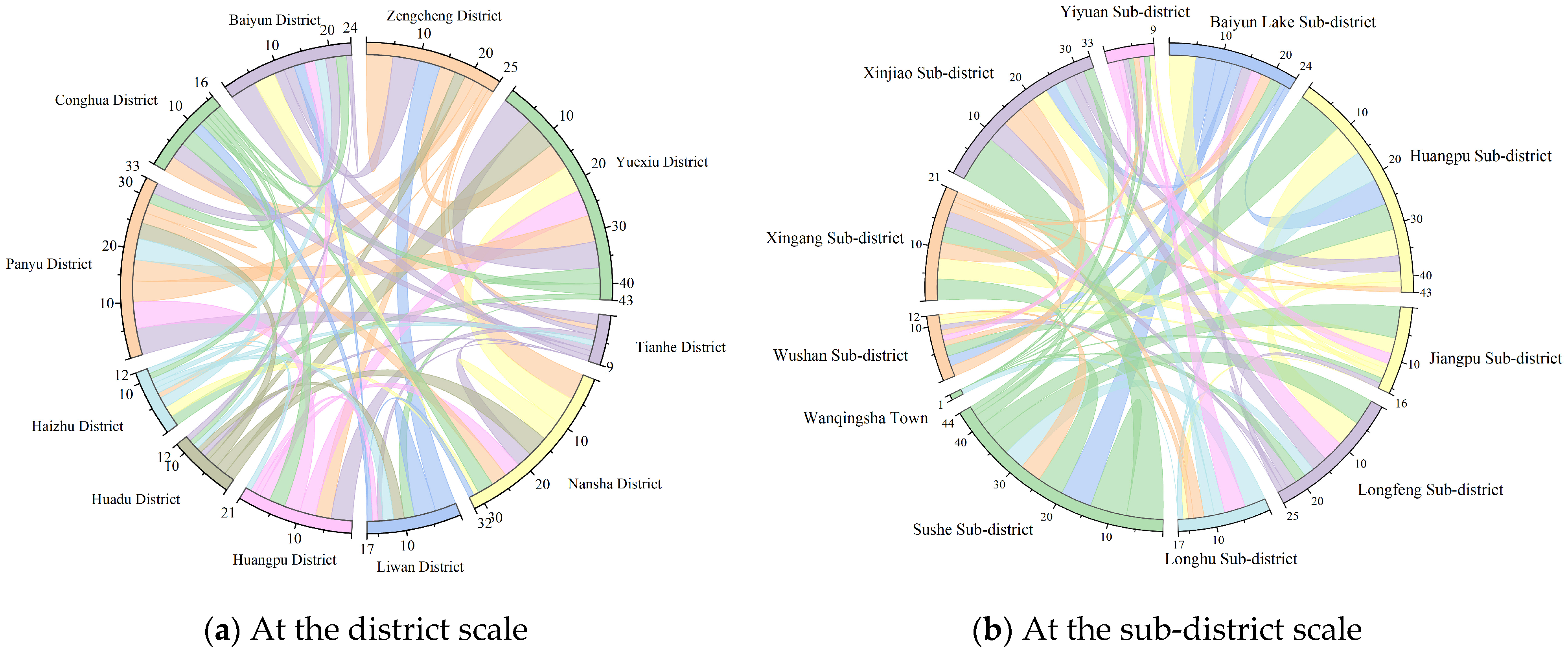
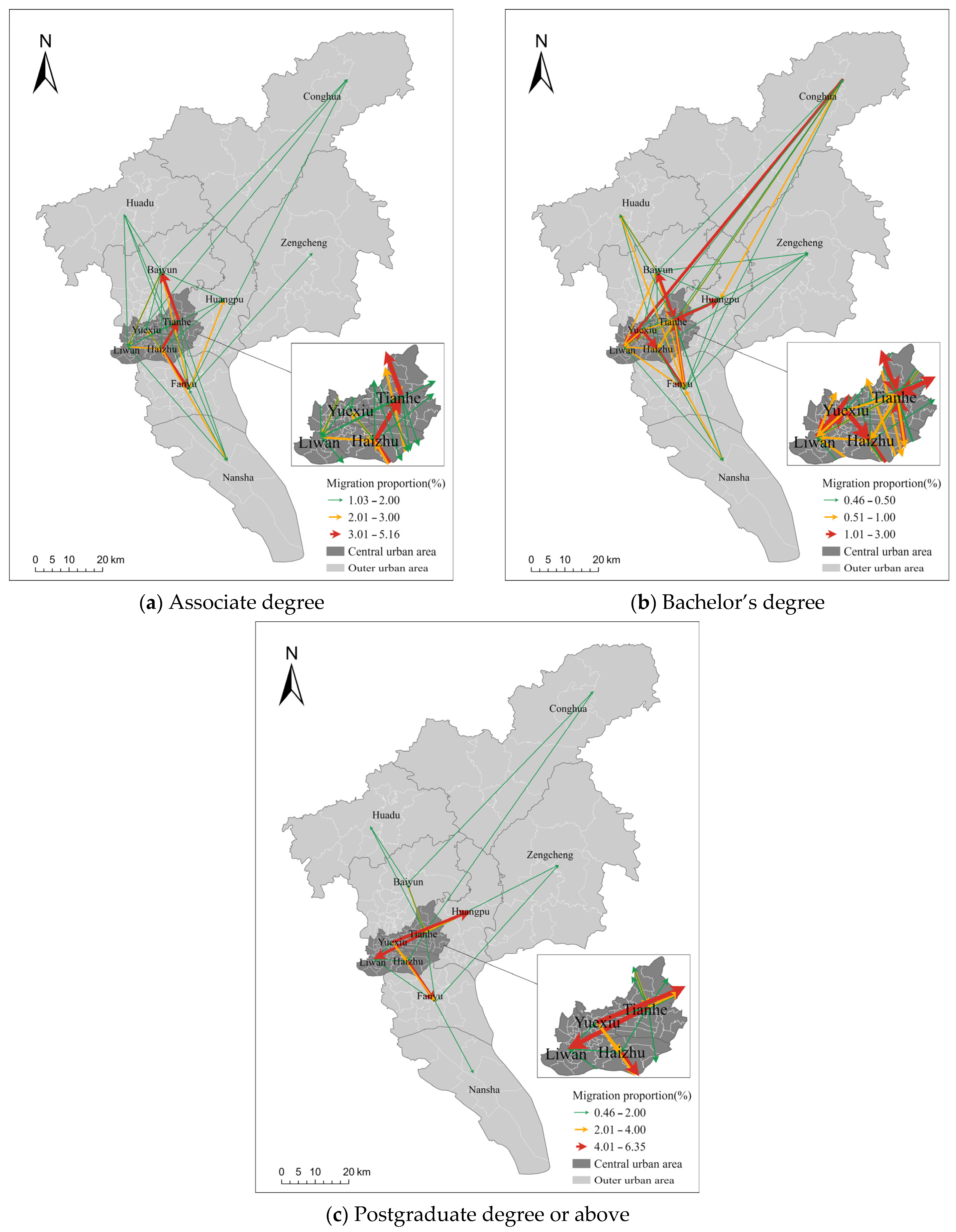
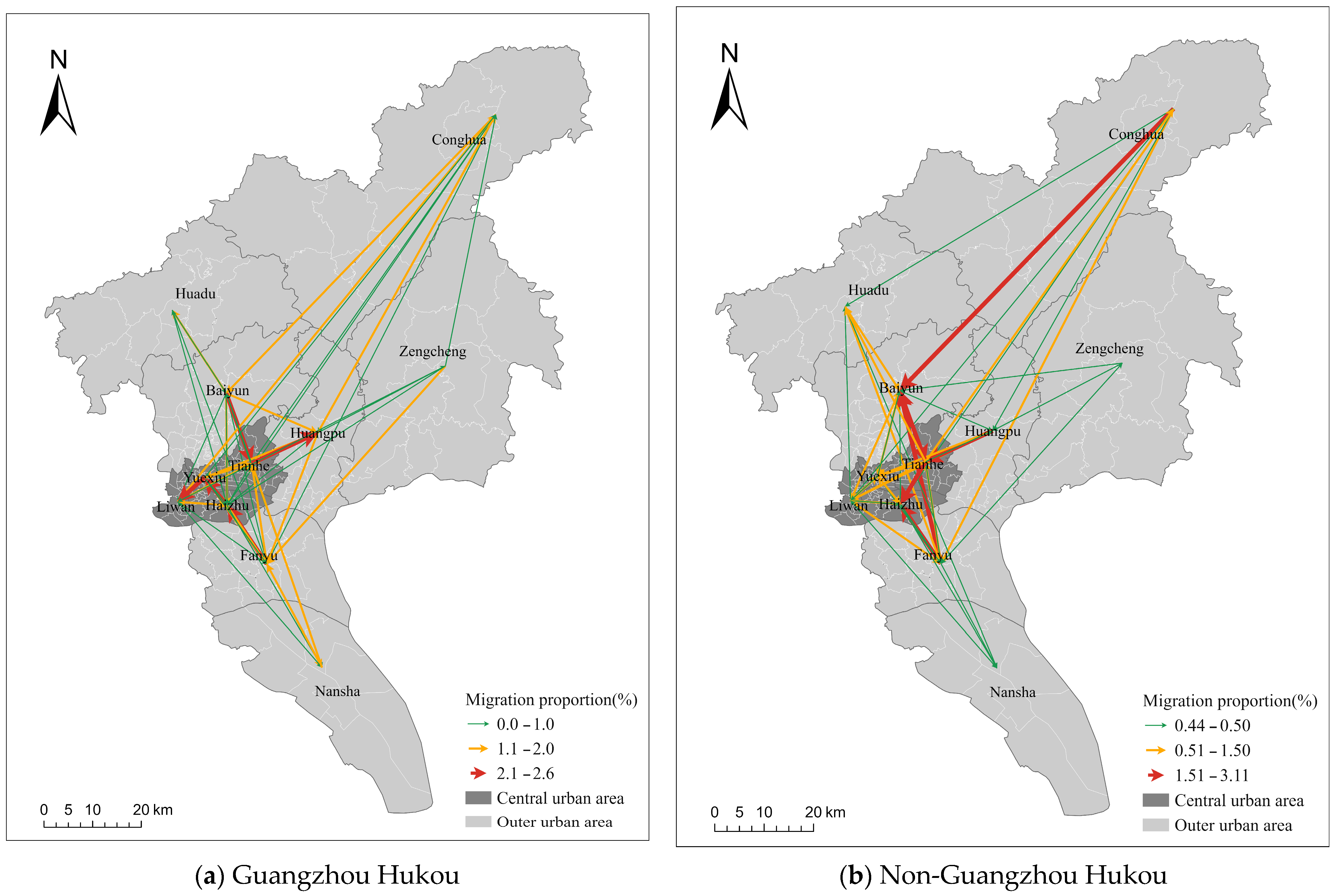
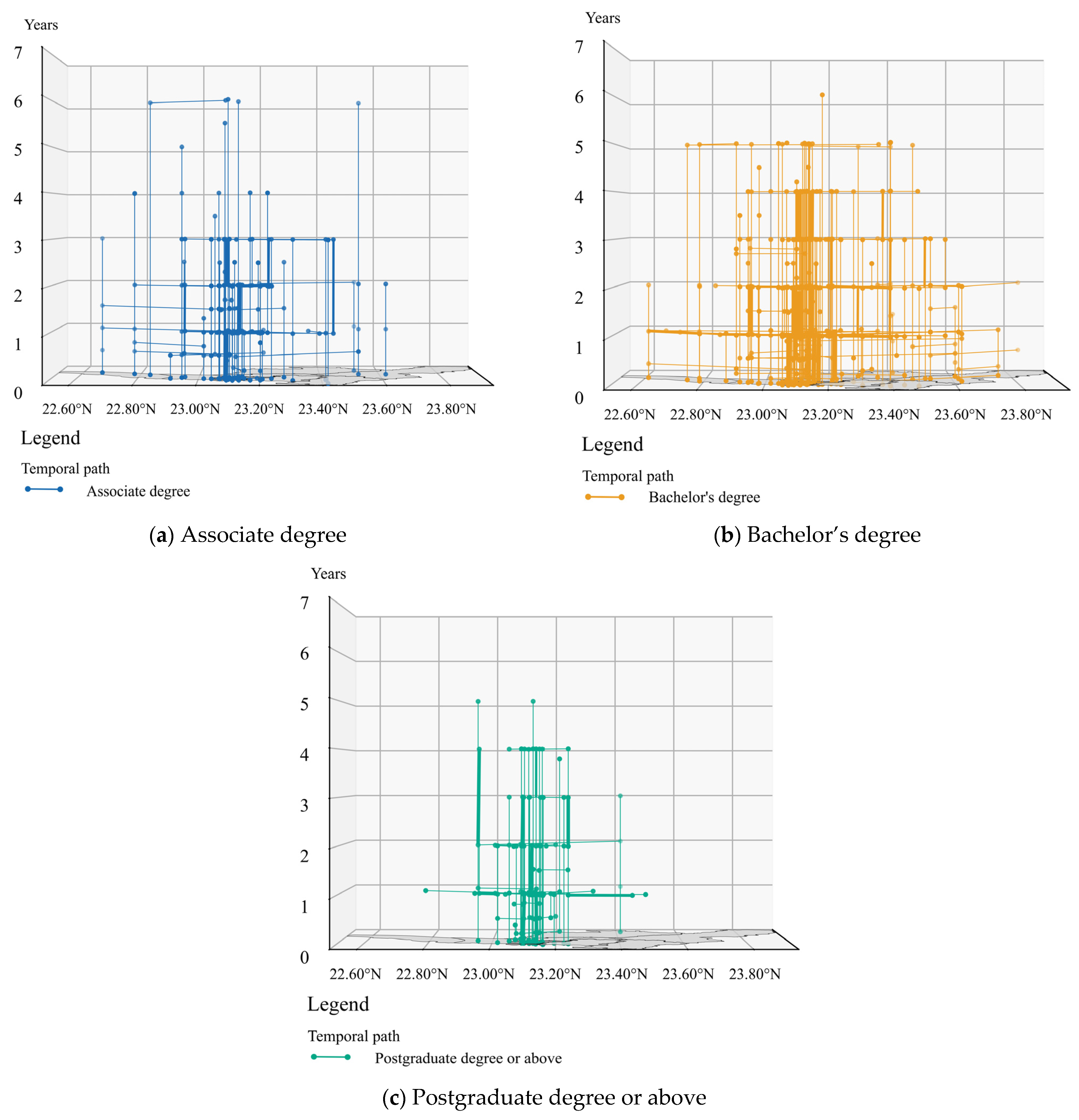
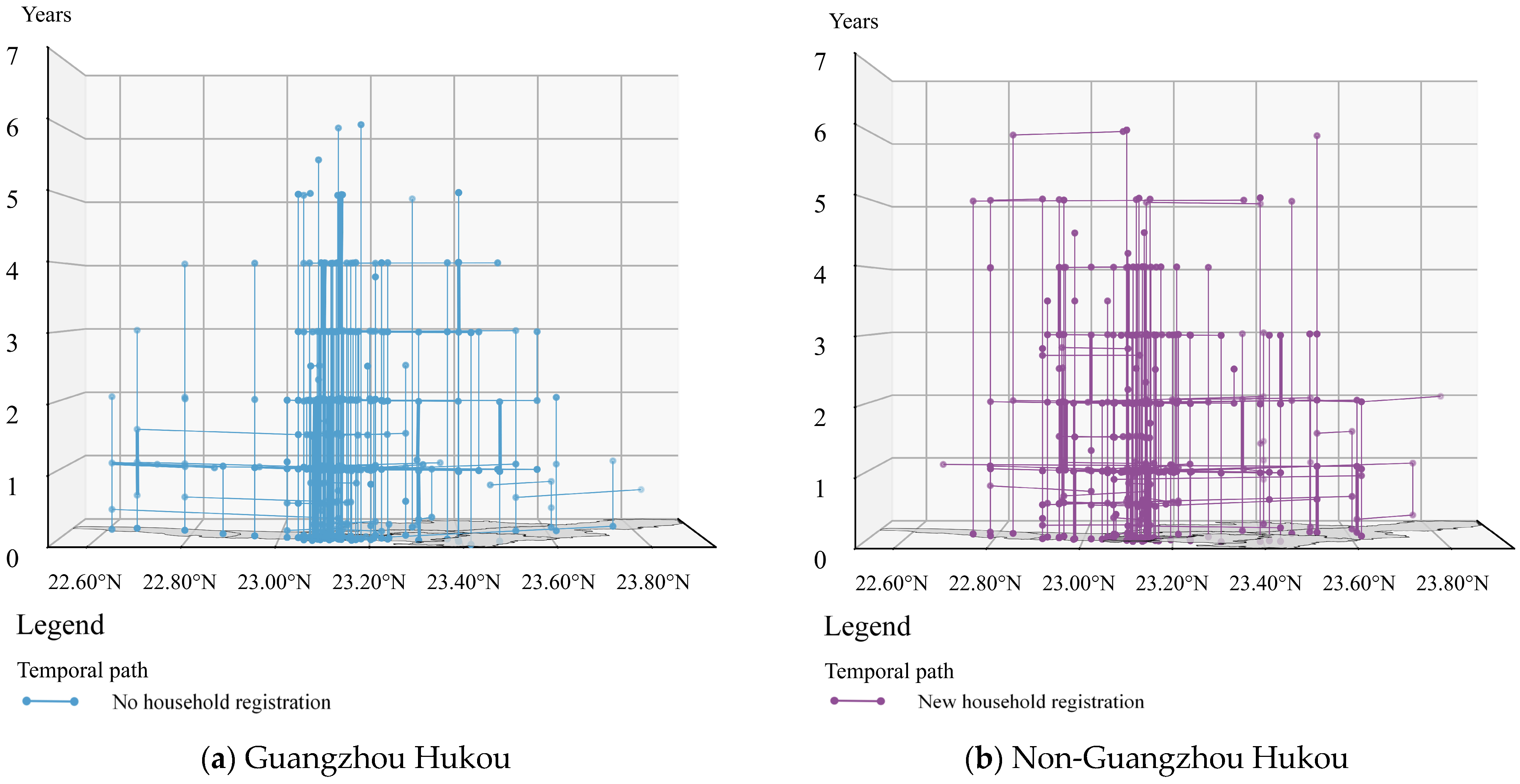
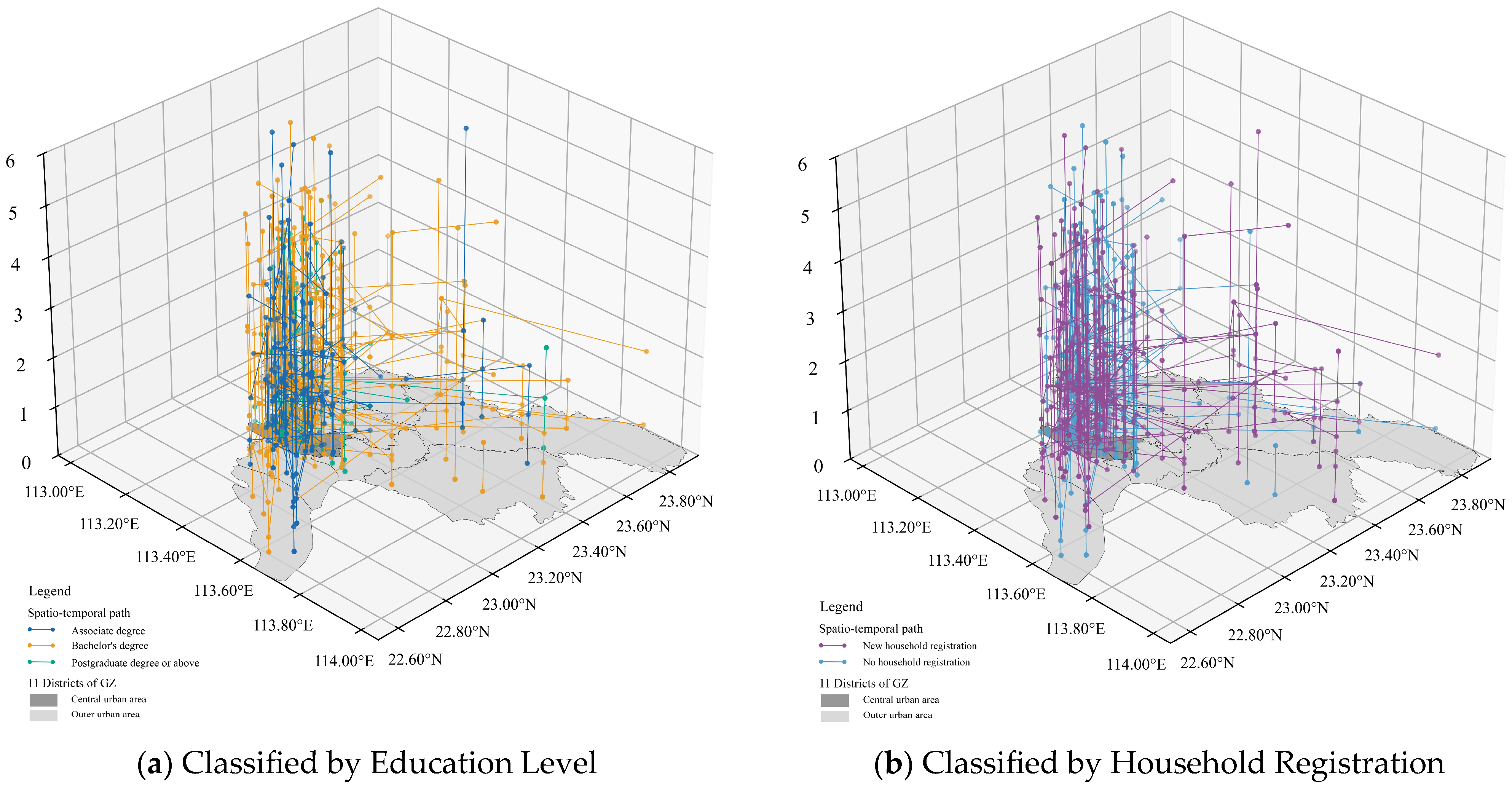
| Sampling Method | Specific Channels | Frequency |
|---|---|---|
| Online | University career centers and alumni networks in Guangzhou | 129 |
| Social media platforms such as WeChat and Weibo | 93 | |
| Internal communication channels of enterprises | 121 | |
| Offline | Residential areas with high concentrations of NECGs | 201 |
| High-density commercial centers | 149 | |
| Large-scale job fairs in Guangzhou | 69 |
| Attributes | Categories | Full Sample (N = 762) | 2024 Guangdong Graduate Population Data | ||
|---|---|---|---|---|---|
| Frequency | Proportion (%) | Proportion (%) | |||
| Life Course Attributes | Gender | Male | 386 | 50.7 | 51.1 |
| Female | 376 | 49.3 | 48.9 | ||
| Marital Status | Married | 130 | 17.1 | — | |
| Unmarried/Others | 632 | 82.9 | — | ||
| Number of Children | 0 | 562 | 73.7 | — | |
| 1 | 122 | 16.0 | — | ||
| 2 or More | 78 | 10.3 | — | ||
| Housing Attributes | Housing Ownership | Owner-occupied | 96 | 12.6 | — |
| Rental | 428 | 56.2 | — | ||
| Others | 238 | 31.2 | — | ||
| Housing Type | Commercial Housing | 278 | 36.5 | — | |
| Others | 484 | 63.5 | — | ||
| Living Area | 0–10 m2 | 168 | 22.1 | — | |
| 10–20 m2 | 175 | 22.9 | — | ||
| 20–50 m2 | 276 | 36.2 | — | ||
| 50 m2 or Above | 143 | 18.8 | — | ||
| Residential Location | Central Urban Area | 356 | 46.7 | 43.2 | |
| Suburban Area | 408 | 53.3 | 56.8 | ||
| Accessibility Attributes | Commuting Time | 0–30 min | 422 | 55.4 | — |
| 30–60 min | 175 | 23.0 | — | ||
| 60 min or Above | 165 | 21.6 | — | ||
| Commuting Costs | CNY 0–500 | 378 | 49.6 | — | |
| CNY 500–1000 | 292 | 38.3 | — | ||
| CNY 1000 or More | 92 | 12.1 | — | ||
| Socioeconomic Attributes | Household Registration | Guangzhou Hukou | 358 | 46.9 | — |
| Non-Guangzhou Hukou | 404 | 53.1 | — | ||
| Educational Level | Associate degree | 258 | 33.9 | 37.2 | |
| Bachelor’s degree | 376 | 49.3 | 48.5 | ||
| Postgraduate or higher | 128 | 16.8 | 14.3 | ||
| Type of Institution | Science/Engineering/Agriculture/Medicine | 166 | 21.8 | 18.8 | |
| Teacher Education/Finance/Law/Political Science | 72 | 9.5 | 8.3 | ||
| Ethnic Studies/Language/Arts | 110 | 14.4 | 15.8 | ||
| Comprehensive | 414 | 54.3 | 57.1 | ||
| Employment Status | Full-time Employment | 480 | 62.9 | — | |
| Flexible Employment | 130 | 17.0 | — | ||
| Never Employed | 70 | 9.1 | — | ||
| Other | 82 | 11.0 | — | ||
| Monthly Income | CNY 0–5000 | 154 | 20.1 | — | |
| CNY 5000–10,000 | 384 | 50.2 | — | ||
| CNY 10,000 or More | 232 | 29.7 | — | ||
| Number of Residential Mobility Occurrences | Number of Residential Mobility Occurrences | 0 Times | 436 | 57.2 | — |
| 1 Time | 270 | 35.5 | — | ||
| 2 or More Times | 56 | 7.3 | — | ||
| Dependent Variable: Residential Mobility Location Choices (Reference Group: Central-Central) | Central-Peripheral Exp (β) | Peripheral-Central Exp (β) | Peripheral-Peripheral Exp (β) | |
|---|---|---|---|---|
| Independent Variable Type | Independent Variable Name | |||
| Life-course Attributes | Gender (Female) | |||
| Male | −0.775 | 0.147 * | 0.404 | |
| Marital Status (Other) | ||||
| Unmarried | −0.53 | 0.457 | 17.879 ** | |
| Married | −1.101 | −0.004 | 16.985 | |
| Age | −0.021 | −0.009 | 0.006 | |
| Housing Market Attributes | Housing Ownership Change (Other) | |||
| Continuous Rental | −0.256 | 0.181 | 0.123 | |
| Owner-occupied to Rental | −0.586 | 1.204 | 0.462 | |
| Rental to Owner-occupied | −2.215 | 0.237 | 0.125 | |
| Continuous Owner-occupied | −0.128 | 0.202 | 0.14 | |
| Changes in Housing (Increase) | ||||
| Decrease | −0.502 | −1.124 *** | −1.321 | |
| Remain Largely Unchanged | −0.401 *** | −1.232 | −1.032 | |
| Housing Type (Commercial housing) | ||||
| Others | −0.586 | 0.168 | 0.366 | |
| Housing Area Change (Increase) | ||||
| Decrease | −0.468 | −0.334 | −0.353 | |
| Remain Largely Unchanged | −2.289 ** | −0.436 | −0.591 | |
| Changes in Commercial Facilities (Increase) | ||||
| Decrease | −1.839 *** | 0.552 | 0.042 | |
| Remain Largely Unchanged | −1.188 | −1.203 | −1.524 | |
| Changes in Educational Resources (Increase) | ||||
| Decrease | 0.234 ** | 1.311 | −0.118 | |
| Remain Largely Unchanged | −0.402 | −0.985 | −1.450 * | |
| Changes in Medical Facilities (Increase) | ||||
| Decrease | 0.493 *** | 0.422 | 0.632 | |
| Remain Largely Unchanged | 0.106 | 0.414 | −0.023 * | |
| Accessibility Attributes | Commuting Costs Change (Increase) | |||
| Decrease | 0.441 | −0.81 | 0.243 | |
| Remain Largely Unchanged | 0.091 | 0.829 | −0.136 | |
| Commuting Distance Change (Increase) | ||||
| Decrease | −0.035 | −1.219 * | −0.536 | |
| Remain Largely Unchanged | −0.028 | −0.263 | 0.325 | |
| Socioeconomic Attributes | Household Registration (Non-Guangzhou) | |||
| Guangzhou | 0.329 | −0.055 | 1.183 ** | |
| Educational Level (Postgraduate or higher) | ||||
| Vocational College | −0.981 | 0.073 | 0.336 | |
| Undergraduate | −0.587 | 0.078 | 0.723 | |
| Disciplinary Categories (Comprehensive) | ||||
| Teacher Education/Finance/Law/Political Science | 0.273 | −0.509 | 0.741 | |
| Science/Engineering/Agriculture/Medicine | −0.297 | −0.502 | −0.596 | |
| Ethnic Studies/Language/Arts | 1.046 | 0.724 | 0.926 | |
| Job Type (Other) | ||||
| Full-time Employment | 0.992 | 0.295 | 1.236 * | |
| Flexible Employment | 0.226 | −0.434 | −0.053 | |
| Never Employed | −1.413 | −1.579 | 0.046 | |
| Monthly Income | 0.006 | −0.06 | −0.009 | |
| Duration of Residence in Guangzhou | −0.046 | −0.095 | −0.045 | |
| Employer Type (Other) | ||||
| Corporate Unit/Company | 0.05 | −1.948 ** | −0.646 | |
| Public Institution | −0.966 | −1.74 * | −0.908 | |
| Government Agency | −1.499 | −1.2 | 0.092 | |
| Social Organization | 0.671 | −2.153 | 0.339 | |
| Constant Term | 1.509 | 1.731 | −19.376 ** | |
| Valid Sample Size: 762 | ||||
| Pseodu R2: 0.674 | ||||
| Loglikelihood:821.25 | ||||
| Wald Test (chi2): 185.74 | ||||
Disclaimer/Publisher’s Note: The statements, opinions and data contained in all publications are solely those of the individual author(s) and contributor(s) and not of MDPI and/or the editor(s). MDPI and/or the editor(s) disclaim responsibility for any injury to people or property resulting from any ideas, methods, instructions or products referred to in the content. |
© 2025 by the authors. Published by MDPI on behalf of the International Society for Photogrammetry and Remote Sensing. Licensee MDPI, Basel, Switzerland. This article is an open access article distributed under the terms and conditions of the Creative Commons Attribution (CC BY) license (https://creativecommons.org/licenses/by/4.0/).
Share and Cite
Dai, X.; Zhou, C.; He, X. Spatio-Temporal Paths and Influencing Factors of Residential Mobility in Guangzhou: A Micro-Level Perspective of Newly Employed College Graduates. ISPRS Int. J. Geo-Inf. 2025, 14, 202. https://doi.org/10.3390/ijgi14050202
Dai X, Zhou C, He X. Spatio-Temporal Paths and Influencing Factors of Residential Mobility in Guangzhou: A Micro-Level Perspective of Newly Employed College Graduates. ISPRS International Journal of Geo-Information. 2025; 14(5):202. https://doi.org/10.3390/ijgi14050202
Chicago/Turabian StyleDai, Xiangjun, Chunshan Zhou, and Xiong He. 2025. "Spatio-Temporal Paths and Influencing Factors of Residential Mobility in Guangzhou: A Micro-Level Perspective of Newly Employed College Graduates" ISPRS International Journal of Geo-Information 14, no. 5: 202. https://doi.org/10.3390/ijgi14050202
APA StyleDai, X., Zhou, C., & He, X. (2025). Spatio-Temporal Paths and Influencing Factors of Residential Mobility in Guangzhou: A Micro-Level Perspective of Newly Employed College Graduates. ISPRS International Journal of Geo-Information, 14(5), 202. https://doi.org/10.3390/ijgi14050202







